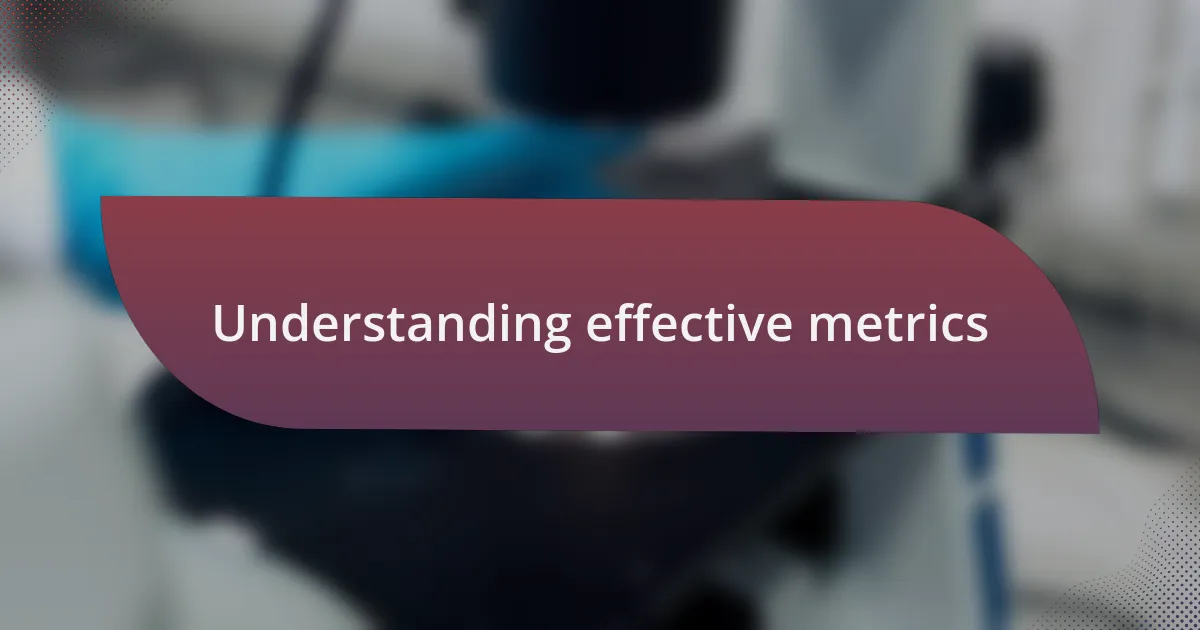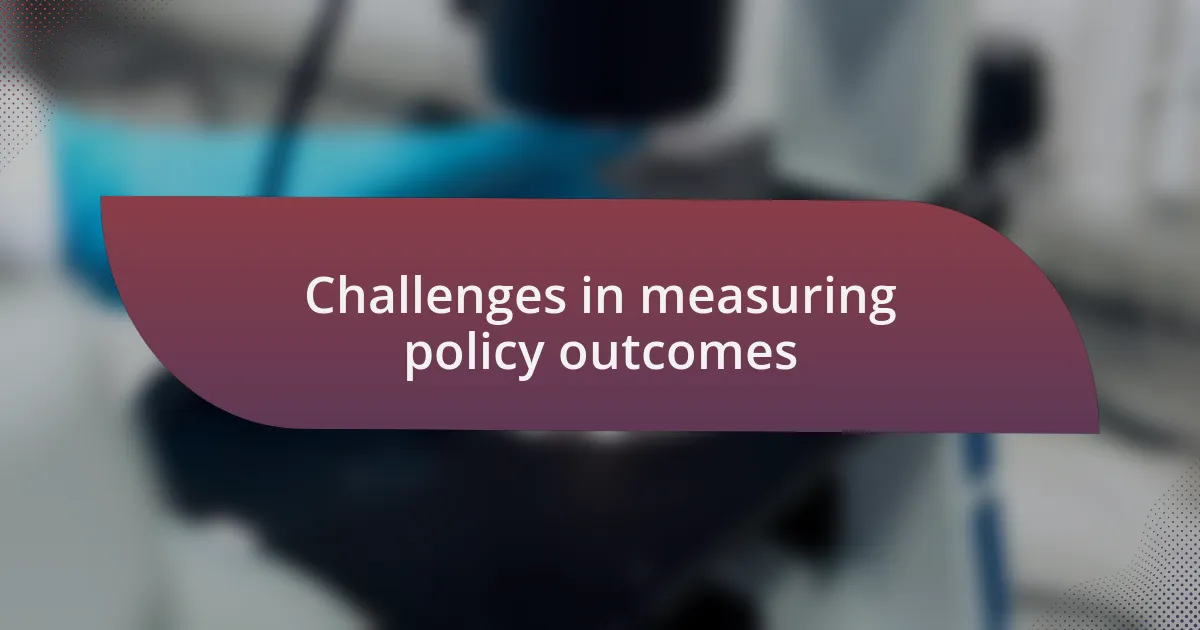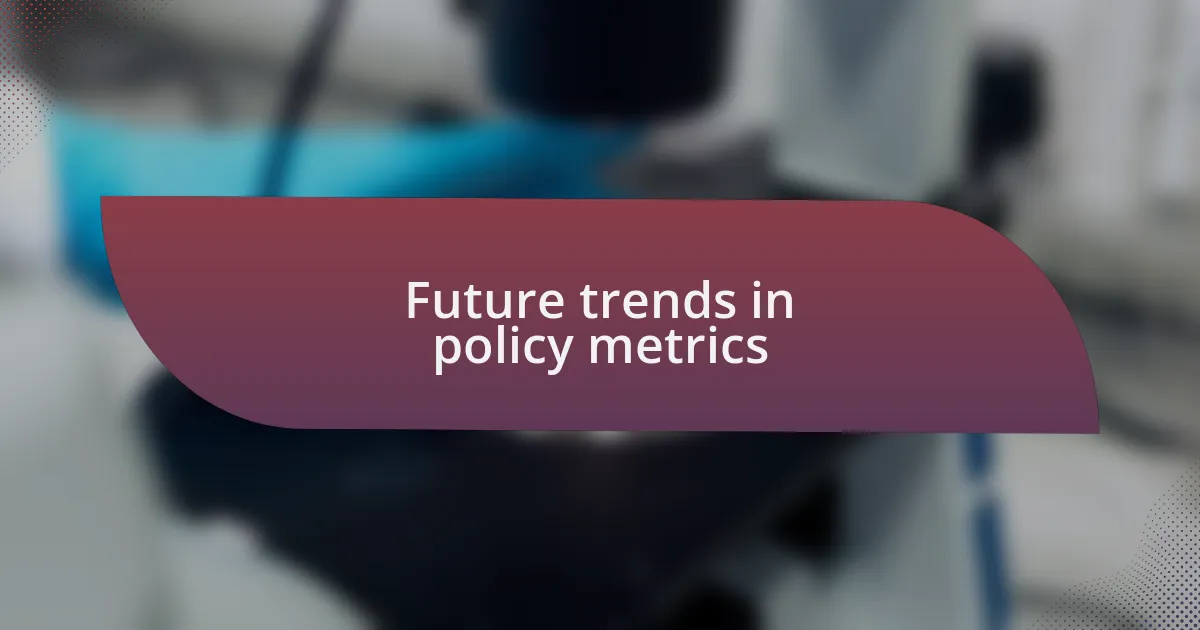Key takeaways:
- Effective metrics should capture deeper insights and the human element behind the data, providing context beyond mere numbers.
- Qualitative feedback is essential for revealing lived experiences and filling gaps that quantitative metrics may overlook.
- Challenges in measuring policy outcomes include the time lag in results and the impact of external factors, complicating true evaluation.
- Future trends in policy metrics should focus on real-time data analytics, qualitative insights, and interdisciplinary approaches for a comprehensive understanding.

Understanding effective metrics
Effective metrics are more than just numbers; they represent a narrative of progress and impact. I remember a project where we tracked community engagement through surveys. Initially, the data felt overwhelming, but soon I realized that understanding the context behind these metrics – like demographics or feedback themes – told a much richer story about our initiatives.
When considering what makes a metric effective, I often ask myself: does it truly reflect the intended goals? One time, our team focused on sheer attendance figures, only to discover they provided little insight into actual interest or satisfaction. It’s a reminder that metrics should not only measure outputs but also capture deeper insights that guide meaningful decision-making.
The emotional component of metrics can’t be overlooked either. When I analyzed the impact of our policy research, I didn’t just look at the statistics; I connected with those affected. I recall speaking to individuals who were directly impacted, and their stories brought life to the cold hard data. By understanding the human element behind the metrics, we can ensure that our research resonates on a personal level, leading to actionable outcomes.

Personal reflections on metric effectiveness
The effectiveness of metrics often hinges on their alignment with real-world impact. I think back to a time when we evaluated a policy initiative solely based on numbers. While the figures suggested success, I found myself questioning: what was the lived experience of those involved? That inquiry led us to focus on qualitative feedback, which unveiled gaps that the numbers alone had concealed.
I also find it fascinating how metrics can evoke emotions and drive action. Once, during a presentation of our findings, I shared a story of someone profoundly affected by our policy recommendations. Witnessing the audience’s reaction reminded me that behind every statistic is a real life, full of challenges and triumphs. This connection reinforces the idea that metrics should not just inform but inspire us to act.
Reflecting on my journey with metrics, I’m sometimes surprised by their ability to change perspectives. In one particularly eye-opening session, a colleague shared their struggle with data interpretation. It struck me that even the most effective metrics can mislead if we don’t engage in open dialogue about their implications. This realization emphasizes the need for collaboration and discussion, as it is through these conversations that we can truly harness the power of metrics.

Challenges in measuring policy outcomes
Measuring policy outcomes can be unexpectedly complicated. I recall a project where we tried to assess a social program’s effectiveness using standardized metrics. While the data seemed promising, I couldn’t shake the feeling that it lacked depth – it begged the question: are numbers enough to truly capture the nuances of people’s experiences within that program?
Another challenge I often encounter is the time lag in seeing results. I remember discussing a health initiative with colleagues, eager to quantify its success. However, the outcomes wouldn’t materialize for months, leaving us wrestling with uncertainty. It made me wonder: how do we hold ourselves accountable for policies whose impacts we can’t measure in real-time?
Lastly, navigating the variability of external factors presents another hurdle in measuring policy outcomes. After evaluating an environmental policy, I realized how external circumstances, like economic changes or community engagement levels, could skew our interpretation of data. This highlighted a crucial thought – can we ever truly isolate the effects of our policies when they are subject to the ebb and flow of society?

Future trends in policy metrics
As I look ahead, one emerging trend in policy metrics is the integration of real-time data analytics. I remember a tech-savvy team I collaborated with; they used live data streams to evaluate urban transport policies. This immediate feedback loop allowed us to make adjustments on the fly, truly transforming how we measured effectiveness. Imagine responding to public concerns almost instantaneously; how empowering would that be for policymakers?
The rise of qualitative metrics also stands out to me as a vital direction forward. In my own experiences, I’ve often found that data alone can obscure the human stories behind policy impacts. For instance, when we included personal narratives from program participants in our evaluations, the insights became richer and more actionable. Could these qualitative insights help us bridge the gap between numbers and real-world experiences, allowing for a more holistic understanding of policy effectiveness?
Another noteworthy trend is the emphasis on interdisciplinary approaches in policy evaluation. Reflecting on a project where education, health, and economics intersected, I was struck by how collaboration across fields generated more comprehensive metrics. This experience raised an important question for me: as policies become increasingly multifaceted, wouldn’t it make sense to adopt a more integrated methodology for measurement? The answer seems clear—it’s time to embrace complexity in our metrics to keep pace with the evolving landscape of policy challenges.